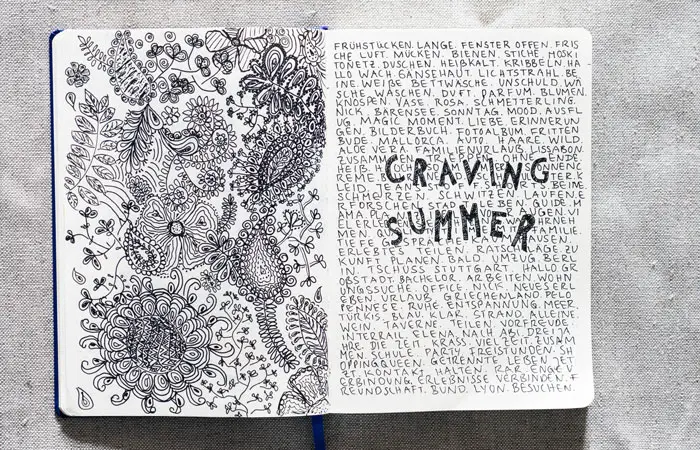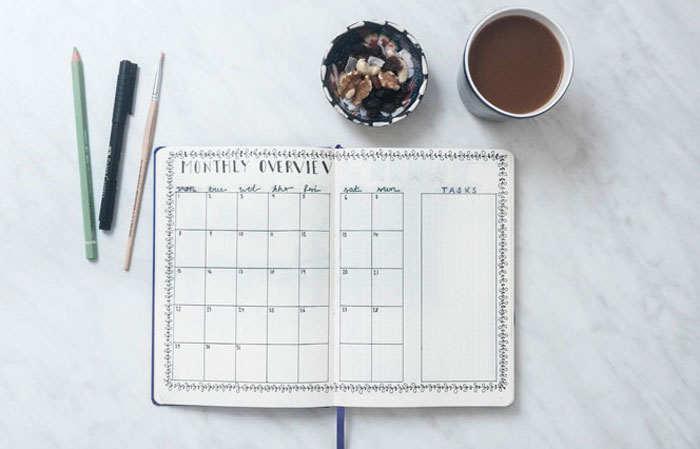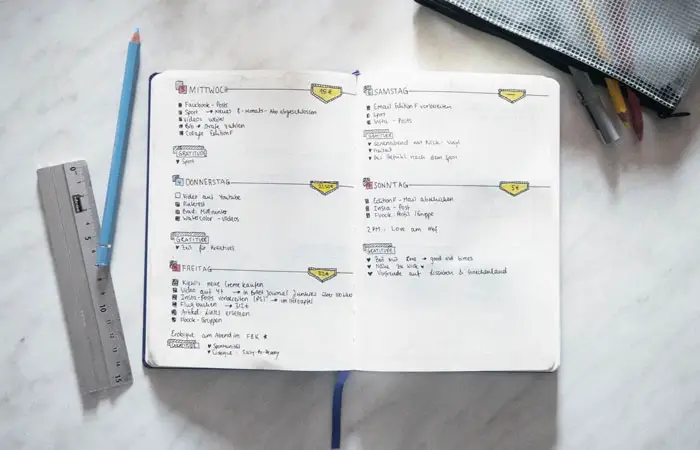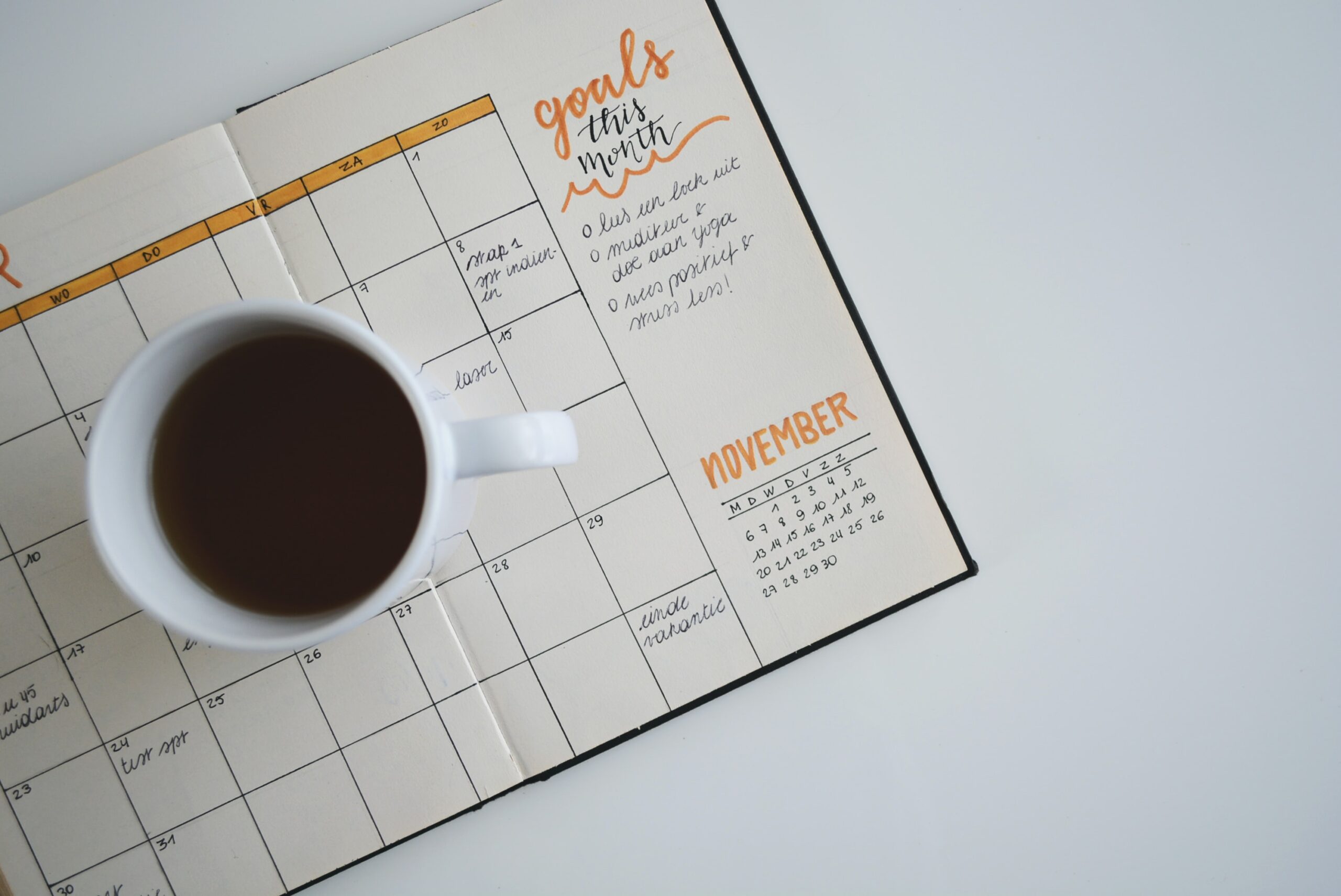Bullet journals are on everyone’s lips. The individual calendar books are intended to help you get your everyday life in order. We will introduce you to the bullet journal method and explain how you can best start using it yourself.
tl,dr: Bulletproof Journal gives you everything you need in a bullet journal—in a simple way.

What is a bullet journal?
A Bullet Journal is a notebook that you design into your very own personal calendar. It should help you to organize yourself better and bring structure to your tasks and goals, whether professional or private.
Who invented it? Not the Swiss. A man named Ryder Caroll! The digital product designer, born in Vienna, now based in New York, wanted to better structure and organize his life and everyday life. This is how his bullet journal method was born.
To date, no planning system had satisfied Caroll, was flexible and customizable enough. The Bullet Journal is exactly that. Carroll describes it as “an evolving, adaptable practice meant to be self curated as you determine what works best for you”. Means: You buy a notebook with dotted lines, in technical jargon “dotted” – either the currently most popular and often sold-out variant of Leuchtturm1917 or a perfectly normal notebook and adapt it to your own needs.
The name Bullet Journal comes from its own system of bullets, i.e. the bullet points. Bullet points are used for tasks, dashes for notes and circles for meetings and appointments. If you have completed a task, you can put an “X” on the key point, uncompleted tasks are moved to the next day with “>” and noted there again.
Aside from the bullet rules and dotted lines (these are really essential!), it’s up to you what you make of your journal, how you build your planner, and come up with the structure that works best for you.
But remember: Every bullet journal starts with a blank notebook of your choice.

Why is a Bullet Journal useful?
According to Ryder Carroll’s book The Bullet Journal Method, the method shows you “how to finally become the pilot of your life and no longer remain a passenger”.
Sounds too good to be true?
Reasons why you need a bullet journal
Six reasons why the bullet journal is so much better than the good old calendar, according to its fans:
One bullet journal book, umpteen functions: A bullet journal is more than a calendar. It is also a notebook, project planner, collection of ideas, coloring book and much more.
Flexibly adaptable: Design the Bullet Journal according to your wishes and needs. You decide what you need in your personal planner – and what you’d rather do without.
Practicing mindfulness: When designing your individual calendar, you automatically take the time to think about your to-dos, plans and goals. The method helps you to organize your days more consciously.
Have fun and get creative: Hand lettering, small sketches and drawings, colored markings and much more make your Bullet Journal your very personal, individual notebook and planner.
Achieving goals: The method helps you to track and measure long-term goals.
Bring clarity and structure to your everyday life: The well thought-out, flexible system supports you in recording and planning your to-dos and appointments.
Ideas for your bullet journal
The great thing about bullet journaling: there are no limits to your creativity!
In addition to your professional and private to-dos, you can create additional projects and goals on extra pages. A few ideas for your bullet journal:
Birthday calendar: Create your own birthday calendar that offers an overview of the whole year. You then transfer the individual birthdays to the respective daily plans so that you don’t forget a birthday.
Lists: Keep lists of the books you want to read or the movies you want to see. Collect recipe ideas, New Year’s resolutions, gift ideas, favorite songs, quotes and more.
Tracker: With a habit tracker you record certain habits to see, for example, whether you drink enough every day, how often you exercise or when you go to bed. Household trackers help you keep track of household chores (washing, vacuuming, taking out the trash…)
The bullet journal also has space for lists of all kinds. For example, record which books you want to read.
What do you need for a self-designed bullet journal?
Not much: a notebook with blank (or lined/squared) pages and a pen will do for starters. A ruler is also helpful.
If you want to be creative, you usually need a little more: pens and markers in different colors and thicknesses, washi tapes, colored paper clips and more.
Bullet journaling for beginners
There is no “right” or “wrong”: You design your bullet journal according to your needs.
How do I start keeping a bullet journal?
Grab your notebook of choice, whether the pages are blank, squared or lined. With a pen and ruler, start laying out the pages.
Important: There is no such thing as “right” or “perfect” when it comes to bullet journaling! You design your journal the way you like it and how you need it for your purposes. Because the goal is that you can be as productive as possible with your personal bullet journal and achieve your goals!
How to create your bullet journal
Number the pages of your notebook
Create a table of contents (index) on the first few pages so that you can find your entries more quickly later. The index is of course empty at first. You fill it up with each new entry.
The table of contents, also index, gives you an overview of your entries.
An overview of the year follows on the next free pages.
Then create your monthly plan. It gives you an overview of the entire coming month. Also leave space for notes.
Next, set your weekly and daily schedules
Also, you can add extra pages for your personal projects or preferences.

Future Log in your bullet journal
Usually the Bullet Journal is planned month by month. For all future tasks and appointments, create your so-called “Future Log”. Here you collect everything that is due in the (relatively) distant future and gradually transfer the dates to your current planning.
Weekly schedule bullet journal
Enter all pending tasks and appointments in the weekly schedule. You can start the week on Sunday or Monday, depending on your preference. In a Bulletproof Journal®, you can name the days of the week in any way you want – how cool is that?
How to organize your to-dos with the bullet journal
Once the journal is created, you can enter and organize your tasks and appointments.
Thats how it works:
- Assign points to tasks (“bullets”)
- If a task is “done”, cross out the point with an x.
- If the task is not yet completed, turn the dot into an arrow > and move the task to the next day, for example.
- Of course, you can also use your own icons to help you organize your to-dos.
- Plan and check off tasks in the Bullet Journal
- Completed tasks and appointments are marked with an “x” in the bullet journal. That’s why squares are so convenient.
Tip: It is best to create a key (“Keys”) at the beginning of your notebook, in which you list and explain all the symbols used.

The basic structure of the bullet journal
Most typical, all bullet journal, including my own Bulletproof Journal®, out in April 2022, consists of the following parts:
Index
The first pages of the bullet journal are reserved for the index, i.e. the table of contents. With each additional page that you describe, the index will be expanded. In my index so far there is an overview of the remaining months in 2016, my monthly overview for August, my weekly and daily planner.
Yearly overview
As just mentioned, the index is followed by an annual overview. Since I only started my bullet journal in August, my “yearly overview” only includes five months. This is suitable for entering birthdays, vacations or events that are planned for the long term. The bullet journal’s dotted structure is ideal for drawing straight lines both vertically and horizontally.
Future Log
In the Future Log you write down your personal goals for the coming year, what you want to achieve, which projects you want to devote yourself to primarily. Personally, I have decided against a future log and instead always set short-term goals at the beginning of a new month. Bulletproof Journal simply calls this My Goals.
Monthly overview
After the annual overview comes the monthly overview of the upcoming month. Fixed appointments and tasks are entered here and transferred to the corresponding daily and weekly logs.
Habit Tracker
This is followed by a part that is not absolutely necessary: the habit tracker, an overview to identify sleep and habits, for example. I myself am not yet sure whether the whole thing actually makes sense for me or whether it is going a step too far in terms of self-optimization – especially since I have often forgotten to continue the tracker every day.
![]()
Weekly overview
The week overview is divided into days and topics. We are slowly getting closer to the matter, because now the weekly overview follows. In the beginning I divided them into: work, university, home, meals and me-time. Meanwhile, I’m quite happy with a mixture of a daily overview and lists for my work, household, various projects, the best moments of the week and a small overview for the next week.
Daily Log (Daily To-Do in Bulletproof Journal)
The daily tasks, expenses and highlights are all listed here. Here you write down which tasks and meetings are scheduled for the respective day. In addition, I usually write down my daily expenses. If you are new to bullets, dashes, and circles, you can stick to old favorite boxes—explore the bullet journal at your own pace. It’s really up to you how you design your bullet journal.
Personal
Over time, you will discover what is incredibly useful to you and what you tend not to use at all. Be open to adapting the monthly, weekly and daily logs flexibly, trying out new things and letting off steam. It’s not about doing the ingredients listed above consistently, it’s about putting it on how you need it. So now and then I have a double page that I fill with holiday memories, a list of books that I definitely want to read, or chains of thoughts and irrelevant drawings. Have fun!
Start your own bullet journal
Don’t be afraid to start a bullet journal. Just go ahead and try it out!


